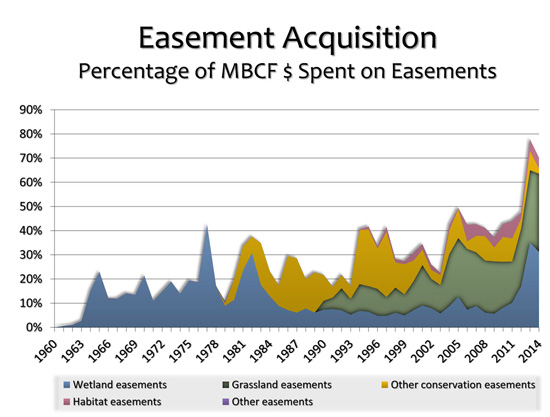
The revealing chart (above) from the Division of Realty (USFWS) shows the percentage of Migratory Bird Conservation Fund (MBCF) dollars going into easements in the Refuge System since the early 1960s.
Easements, of course, are becoming increasingly important for preserving valuable habitats, as clearly indicated on the chart. These have shown impressive growth since the early 1990s, and they have been highly impressive engines of conservation in the last decade.
A wetland easement pays a landowner to permanently protect wetlands. Wetlands covered by an easement cannot be drained, filled, leveled, or burned. (When these wetlands dry up naturally, however, they can be farmed, grazed, or hayed.) Land covered by a permanent grassland easement may not be cultivated. Mowing, haying, and grass seed harvesting must be delayed until after July 15 each year to protect nesting birds.
In the chart, the grassland, wetland, and habitat easement categories all refer to the specific easement documents described in the Service Manual Chapter 341 FW 6. These types of permanent easements, to protect Waterfowl Production Areas (WPAs), are mainly acquired in the five states in the Prairie Pothole Region (PPR), primarily on working ranches or agricultural lands.
Region 6, the mountain-prairie region covering eight states in the American West, and Region 3, the Midwest region also covering eight states, use the same wetland easement standards (shown in dark blue) in the PPR, but they used them somewhat differently.
Region 6 uses the “grassland easement” document (shown in green), and Region 3 uses the “habitat easement” document (shown in purple). Region 3 habitat easement also includes some additional wetlands protection not present in the Region 6 grassland easement.
The “other conservation easement” category (shown in gold) encompasses all other conservation easements. These habitat easements differ from, and are generally more restrictive than, the minimally restrictive easements described above, with specialized easement terms set through negotiations with landowners.
Summarizing, these wetland, grassland, and habitat easements are the three types of easements that the USFWS uses to acquire for Waterfowl Production Areas (WPA) in the PPR, whereas the “other conservation easement” category encompasses all easements acquired for National Wildlife Refuges.
Easements have a vital role to play these days, primarily for waterfowl but also for long-legged waders, shorebirds, terns, gulls, rails, and wetland-associated songbirds. But grassland birds, especially grassland songbirds and a cluster of shorebird species, are benefiting greatly. Easements are the crucial conservation connector for many working lands. Hundreds of landowners in the PPR – especially in the Dakotas – are awaiting permanent easement agreements with the USFWS.
There is a lot more information available from the USFWS on the Wetland Easement Program and the Grassland Easement Program.